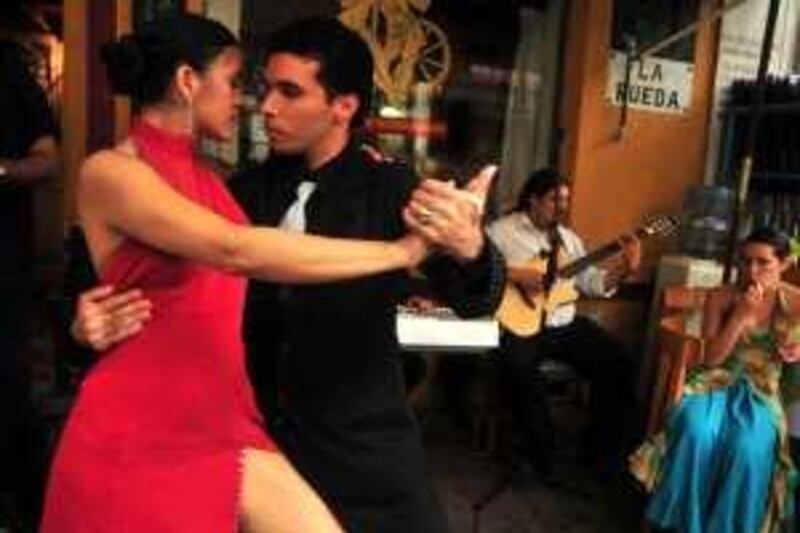BUENOS AIRES // A row that has simmered for generations between Argentina and Uruguay over the origins of the tango looks likely to end this year - with both sides winning. Culture ministries in Buenos Aires and Montevideo have asked Unesco, the UN's cultural agency, to grant the dance world heritage status and declare that it originated in both countries. A Unesco meeting scheduled for Dubai in September is expected to deliver a verdict endorsing their proposal.
For more than a century, Argentina and Uruguay have exchanged charges of cultural hijacking. But this not just about bragging rights. As tango becomes more fashionable, traditionalists in both countries fear its essence could be diluted. "Tango has never been more popular," said Guillermo Alio, 59, an Argentinian tango artist and expert on the history of the dance. "But certain original elements need to be preserved. The dance can be adapted to particular circumstances but its core meaning must remain constant."
Mr Alio teaches tango and paints dance scenes in a studio full of his artworks located in the heart of Boca, a poor Buenos Aires port suburb where many Argentines believe tango originated. He has little time for the wrangling that has characterised the tango spat with Uruguay. "It was born on both sides of the River Plate, in Buenos Aires and Montevideo. That is where the massive wave of immigrants from Italy came ashore in the late 19th century. It is a River Plate dance, not just Buenos Aires or Montevideo but both."
History is repeating itself as tango sweeps the world's dance floors much as it did a century ago. It was a craze before the First World War in the ballrooms of Berlin, London and Paris before a decline set in. Various military dictatorships, suspicious of any street activity that drew crowds, banned it in Argentina during the 1950s. Now it is stepping out with renewed confidence and vigour, but for all its rejuvenated global popularity, few Argentinians actually dance it.
"I would say about one per cent of Argentines can actually do a tango. It is not an Argentine dance as such, but a Buenos Aires one, and in the capital people watch it more than participate," Mr Alio said. Nor is it a merry dance, but rather one of sadness and nostalgia. "Apart from learning the intricate steps and discipline required, tango dancers must have experienced the hardships of life before expressing themselves on the floor. A young couple full of optimism cannot dance a tango."
Born in the slums of Buenos Aires and Montevideo around 1880 as waves of Italian immigrants sought a new life, the dance expresses longing for the homes and loved ones left behind. "Tango without nostalgia is not tango. It is a form of language without words but that language is one of heartache. "Many of the immigrants knew they would never see their family or friends in Italy again, that is what tango expresses. It is not a wave hello to a new country but a long wave goodbye."
The costumes - men in double-breasted suits, women in high heels - were the "clothes of immigrants", but they also served a practical purpose. "It is about freedom of movement," Mr Alio said. "The man leads so the woman has to turn, hence the heels - it is to keep them literally on their toes so they move their feet quickly." As he was speaking, Mr Alio and his wife, Maria del Carmen, put two students from Houston, Texas, through their paces, demanding each painstaking step be executed with distinction and verve.
Yet across from the studio, tourists are being lured into tango coffee shops where dancers pose for photographs and "perform" a tango. Two dancers both in their twenties charge tourists for watching and for a fee will gladly pose for photos. "I am not against 'tourism tango' as such but the trouble is people will think this is the genuine article," Mr Alio said. "What you see in coffee shops like this is just for show and a quick profit. There is no feeling in the dance. It is entertaining to a point but it is not what tango is about. That is why its heritage must be recognised and the reason for the dance understood."
tclifford@thenational.ae






